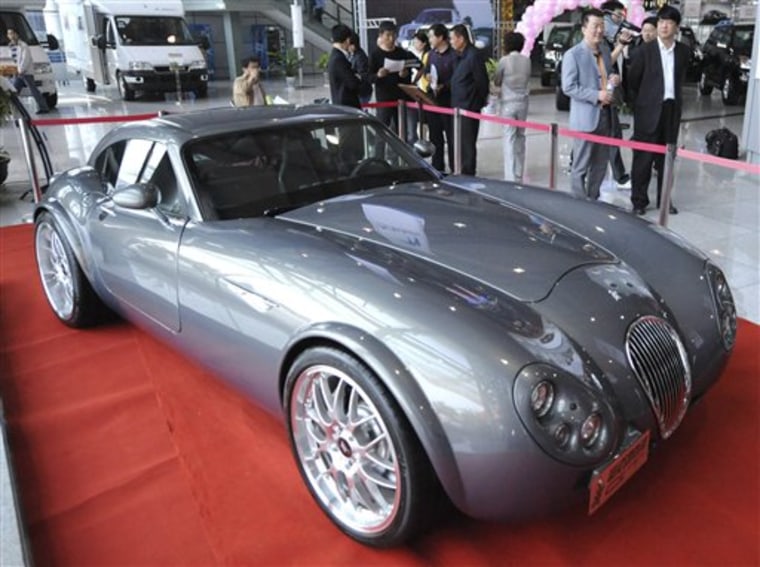International automakers are converging on China’s commercial capital for a show that, once marginal, is now a key showcase — and battleground — for the world’s only major growing car market.
The biennial Shanghai Auto Show, which opens Monday to media and on Wednesday to the public, is expected to feature an unprecedented number of new vehicle launches, reflecting the growing importance of this market for automakers everywhere.
It follows on the heels of Sunday’s Formula One Grand Prix — another Shanghai event symbolizing the city’s obsession with cars.
“The number of new launches, especially from global manufacturers, will set it apart,” says Paul Gao, CFO of Chery Quantum Auto Co., a new unit of Chery Automobile Co. that is developing upscale models for the domestic automaker.
“Many automakers now see the Chinese market as at the forefront,” he said.
Porsche kicked off the show on Sunday night by unveiling the Panamera, the German automaker’s first foray into the luxury sedan segment. Porsche said its decision to reveal the vehicle in China signals the rising importance of the country’s auto market.
Porsche sales in Asia more than doubled in its 2007-2008 fiscal year to 7,600 vehicles, the company said.
“This is a clear signal that we count on these markets and have full confidence in their future economic potential,” Porsche Chief Executive Wendelin Wiedeking said in a statement.
Like the company’s Cayenne SUV, the new four-door Panamera will be built at Porsches plant in Leipzig, Germany. It will be
entering the market in Europe, South America and parts of Asia in September 2009, in North America and Australia in October, and in China in early 2010.
China, the world’s second-biggest car market, has revived sales after a late-2008 slump with tax cuts and rebates that are pulling small vehicles out of showrooms nearly as fast as companies can make them.
Sales hit monthly record of 1.11 million vehicles in March, exceeding U.S. sales for the third month in a row and up 5 percent from a year earlier.
While the surge to the forefront mainly is a result of deteriorating conditions in the U.S. and elsewhere, the gravitational center of the world auto market clearly has shifted to China and other emerging markets.
The uptick in sales this year caught many automakers off guard, since they had cut production in expectations that the slowdown in sales seen last year would persist in China, Gao says.
“There are supply shortages and in some cases, automakers couldn’t meet demand. Joint ventures rely on imported components, and many of the tier-one global suppliers were already on the verge of bankruptcy,” he said.
But these are the kind of headaches automakers pray for at a time when sales in the U.S. market have been plunging by close to 40 percent in annual terms.
China is a lifeline for ailing General Motors Corp., which sold 137,004 vehicles in China in March, up 24.6 percent from a year earlier. Tax cuts and other government policies focused on encouraging sales of small, fuel-efficient cares pushed sales at its minivehicle joint venture, SAIC-GM-Wuling, up 38 percent to 90,784 vehicles.
Kevin Wale, president and managing director of the GM China Group, says GM intends to double its sales in China, to more than 2 million a year, by 2014. Among its strategies: launching or upgrading more than 30 models over those five years.
It’s a far cry from decades past, when vehicles like the VW Santana, a 1980s model made by Volkswagen AG’s joint venture with Shanghai Automotive Industry Corp. that remains the staple of Shanghai’s taxi fleets, were among the few choices on the market.
To compete now, both Chinese and foreign automakers need a full portfolio covering the whole spectrum, from the inexpensive compacts favored by first-time car buyers to the high-margin luxury models needed to compete with foreign-brand sedans.
And vehicles need to be tailored to the preferences of increasingly particular Chinese customers, says Thomas Schiller, managing director of Arthur D. Little China, who specializes in the auto industry.
“It doesn’t work to take some car and just localize it. Chinese customers are now more educated and U.S. designs are shifting to a more Japanese and European model,” he said.
Chinese automakers, still unable to successfully challenge their foreign rivals in affluent Western and Japanese markets, are striving to bring quality up to snuff, while also going after the small-car market where their home player status gives them cost and distribution advantages.
Among those who have made headway: privately owned Geely Automobile Holdings. Based near Shanghai, it has worked hard to upgrade its sedans after floundering in European markets, several analysts said.
Meanwhile, global automakers are struggling to get their products right and to set up strong dealer networks — a major challenge given China’s vast territory and disparate regional markets.
“There is huge potential for first-time car buyers. They will buy a car because they need a car,” Schiller said.
Even now, first-time buyers account for nearly three quarter of sales. But reaching all the hundreds of millions of potential car owners in this market of 1.3 billion people requires new strategies since most of them live outside the traditional auto market centers of Shanghai, Beijing and Guangzhou.
“The biggest challenge for most players is how to enter the tier-three and -four cities,” said Schiller. “It’s a battlefield in the market and it will decide the next two to three years of growth in China.”
